Dariush Salami
Distributed Learning for Wi-Fi AP Load Prediction
Apr 22, 2024



Abstract:The increasing cloudification and softwarization of networks foster the interplay among multiple independently managed deployments. An appealing reason for such an interplay lies in distributed Machine Learning (ML), which allows the creation of robust ML models by leveraging collective intelligence and computational power. In this paper, we study the application of the two cornerstones of distributed learning, namely Federated Learning (FL) and Knowledge Distillation (KD), on the Wi-Fi Access Point (AP) load prediction use case. The analysis conducted in this paper is done on a dataset that contains real measurements from a large Wi-Fi campus network, which we use to train the ML model under study based on different strategies. Performance evaluation includes relevant aspects for the suitability of distributed learning operation in real use cases, including the predictive performance, the associated communication overheads, or the energy consumption. In particular, we prove that distributed learning can improve the predictive accuracy centralized ML solutions by up to 93% while reducing the communication overheads and the energy cost by 80%.
AI/ML-based Load Prediction in IEEE 802.11 Enterprise Networks
Oct 11, 2023Abstract:Enterprise Wi-Fi networks can greatly benefit from Artificial Intelligence and Machine Learning (AI/ML) thanks to their well-developed management and operation capabilities. At the same time, AI/ML-based traffic/load prediction is one of the most appealing data-driven solutions to improve the Wi-Fi experience, either through the enablement of autonomous operation or by boosting troubleshooting with forecasted network utilization. In this paper, we study the suitability and feasibility of adopting AI/ML-based load prediction in practical enterprise Wi-Fi networks. While leveraging AI/ML solutions can potentially contribute to optimizing Wi-Fi networks in terms of energy efficiency, performance, and reliability, their effective adoption is constrained to aspects like data availability and quality, computational capabilities, and energy consumption. Our results show that hardware-constrained AI/ML models can potentially predict network load with less than 20% average error and 3% 85th-percentile error, which constitutes a suitable input for proactively driving Wi-Fi network optimization.
User Localization using RF Sensing: A Performance comparison between LIS and mmWave Radars
May 17, 2022



Abstract:Since electromagnetic signals are omnipresent, Radio Frequency (RF)-sensing has the potential to become a universal sensing mechanism with applications in localization, smart-home, retail, gesture recognition, intrusion detection, etc. Two emerging technologies in RF-sensing, namely sensing through Large Intelligent Surfaces (LISs) and mmWave Frequency-Modulated Continuous-Wave (FMCW) radars, have been successfully applied to a wide range of applications. In this work, we compare LIS and mmWave radars for localization in real-world and simulated environments. In our experiments, the mmWave radar achieves 0.71 Intersection Over Union (IOU) and 3cm error for bounding boxes, while LIS has 0.56 IOU and 10cm distance error. Although the radar outperforms the LIS in terms of accuracy, LIS features additional applications in communication in addition to sensing scenarios.
Energy-Efficient Design for RIS-assisted UAVcommunications in beyond-5G Networks
Sep 24, 2021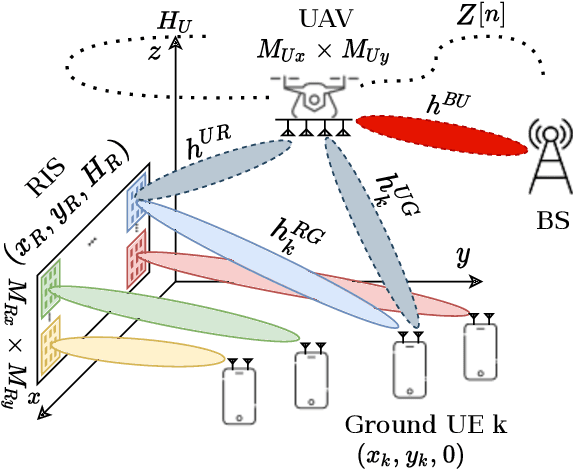
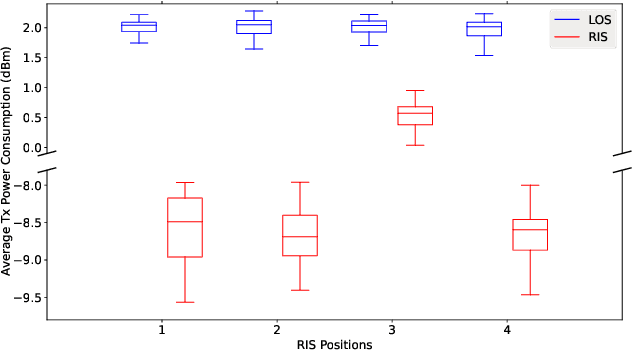


Abstract:The usage of Reconfigurable Intelligent Surfaces (RIS) in conjunction with Unmanned Ariel Vehicles (UAVs) is being investigated as a way to provide energy-efficient communication to ground users in dense urban areas. In this paper, we devise an optimization scenario to reduce overall energy consumption in the network while guaranteeing certain Quality of Service (QoS) to the ground users in the area. Due to the complex nature of the optimization problem, we provide a joint UAV trajectory and RIS phase decision to minimize transmission power of the UAV and Base Station (BS) that yields good performance with lower complexity. So, the proposed method uses a Successive Convex Approximation (SCA) to iteratively determine a joint optimal solution for UAV Trajectory, RIS phase and BS and UAV Transmission Power. The approach has, therefore, been analytically evaluated under different sets of criterion.
Integrating Sensing and Communication in Cellular Networks via NR Sidelink
Sep 15, 2021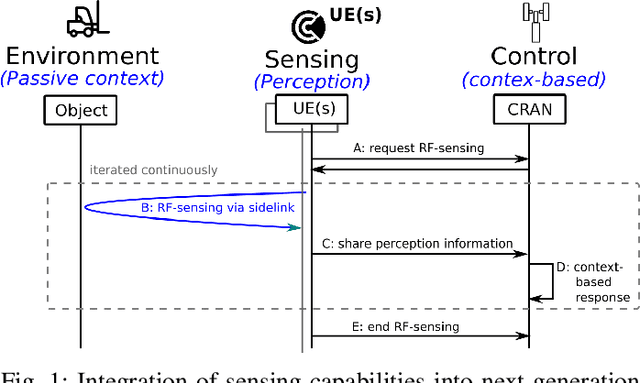

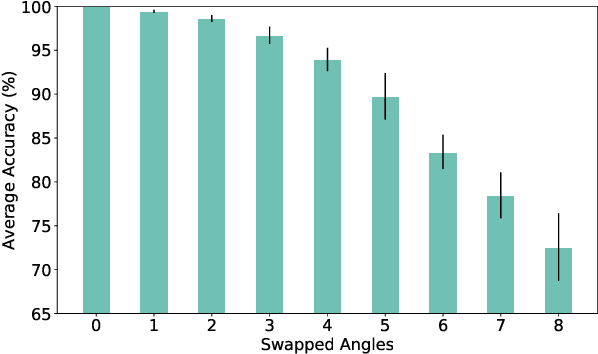
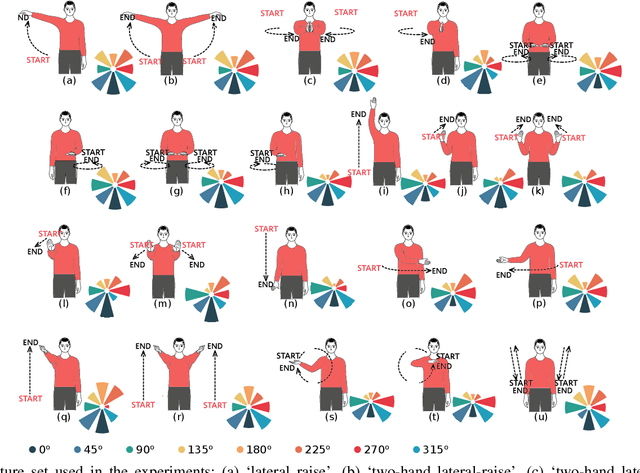
Abstract:RF-sensing, the analysis and interpretation of movement or environment-induced patterns in received electromagnetic signals, has been actively investigated for more than a decade. Since electromagnetic signals, through cellular communication systems, are omnipresent, RF sensing has the potential to become a universal sensing mechanism with applications in smart home, retail, localization, gesture recognition, intrusion detection, etc. Specifically, existing cellular network installations might be dual-used for both communication and sensing. Such communications and sensing convergence is envisioned for future communication networks. We propose the use of NR-sidelink direct device-to-device communication to achieve device-initiated,flexible sensing capabilities in beyond 5G cellular communication systems. In this article, we specifically investigate a common issue related to sidelink-based RF-sensing, which is its angle and rotation dependence. In particular, we discuss transformations of mmWave point-cloud data which achieve rotational invariance, as well as distributed processing based on such rotational invariant inputs, at angle and distance diverse devices. To process the distributed data, we propose a graph based encoder to capture spatio-temporal features of the data and propose four approaches for multi-angle learning. The approaches are compared on a newly recorded and openly available dataset comprising 15 subjects, performing 21 gestures which are recorded from 8 angles.
Tesla-Rapture: A Lightweight Gesture Recognition System from mmWave Radar Point Clouds
Sep 14, 2021
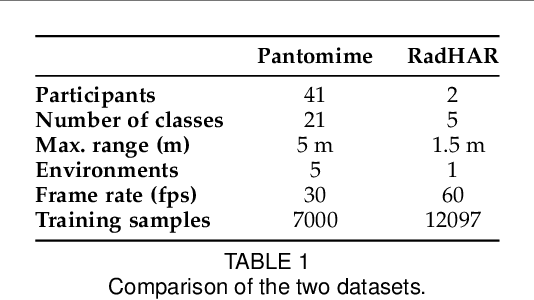

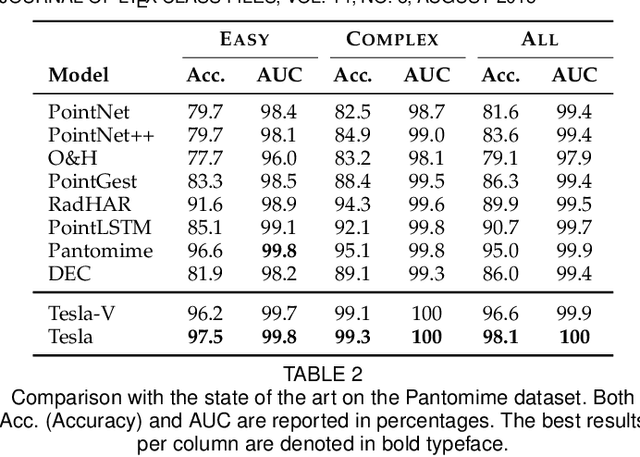
Abstract:We present Tesla-Rapture, a gesture recognition interface for point clouds generated by mmWave Radars. State of the art gesture recognition models are either too resource consuming or not sufficiently accurate for integration into real-life scenarios using wearable or constrained equipment such as IoT devices (e.g. Raspberry PI), XR hardware (e.g. HoloLens), or smart-phones. To tackle this issue, we developed Tesla, a Message Passing Neural Network (MPNN) graph convolution approach for mmWave radar point clouds. The model outperforms the state of the art on two datasets in terms of accuracy while reducing the computational complexity and, hence, the execution time. In particular, the approach, is able to predict a gesture almost 8 times faster than the most accurate competitor. Our performance evaluation in different scenarios (environments, angles, distances) shows that Tesla generalizes well and improves the accuracy up to 20% in challenging scenarios like a through-wall setting and sensing at extreme angles. Utilizing Tesla, we develop Tesla-Rapture, a real-time implementation using a mmWave Radar on a Raspberry PI 4 and evaluate its accuracy and time-complexity. We also publish the source code, the trained models, and the implementation of the model for embedded devices.
 Add to Chrome
Add to Chrome Add to Firefox
Add to Firefox Add to Edge
Add to Edge